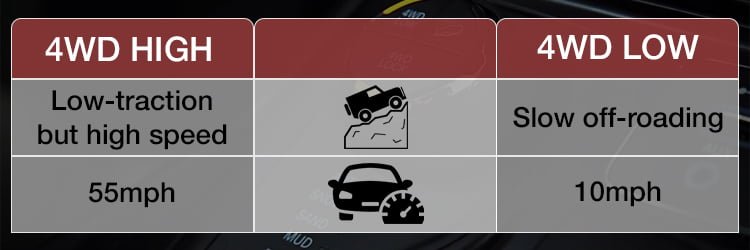One of the most popular settings in off-roading trucks is the 4×4 drivetrain. It’s what most off-roaders engage when out there in rough terrain to help in steady traction.
However, 4WD comes in two modes, the 4WD high and low, and these might become a nuisance if you don’t know how to put them into good use.
We’ll look into what the 4WD high and low mean, how and where to use them, and how fast you can drive in both. Stay put.
4×4 High Vs. Low: What Are They?

How to Use 4WD High and Low?
Appropriate use of the 4×4 high and low is crucial in maintaining a healthy status of your transfer box components, drive train, and transmission system. Let’s first look into what both terms indicate, to begin with.
When you get to rough terrain during your off-roading expeditions, it’s time to switch to a 4-wheel drive. The biggest question will be what mode of 4WD it will be. The 4×4 High, or 4-High, is what you need when you want some extra traction, more than a 4×2 can offer. You can use the 4-High at high speeds or in snowy and slippery conditions. The 4×4 Low, or 4-Low, comes in when you need added torque for some grueling off-roading activity. The 4-Low mostly suits low speeds.
Where can I Drive in 4WD?
Who said that you must engage 4WD every time you tow a trailer to your truck? Well, it isn’t the worst of ideas, but it is an unnecessary practice. 2WD is almost perfect in normal driving, regardless of whether you’re towing along a trailer or not. Then, when is the best time to engage 4WD?
Engaging 4WD is situation-dependent. When off-roading, you will most definitely come across mud, ice, some river, a rocky uphill route, or any other situation that requires increased traction. Now, the type of situation before you determines what mode of 4WD you’ll engage. For the 4-High, it is advisable that once you leave the tarmac onto some dirt road, then you can safely engage it. The 4-High improved the overall traction of your truck on the off-road track.
However, these are some of the situations that will call for the 4-Low;
- Rocky, uneven surfaces
- Deep snow tracks
- Deep mud
- Thick loose sand
- Steep, uneven declines
- Steep, uneven inclines
It is always important to be on the lookout for situations that will require you to switch to 4-high or low and make it easy during gear transition.
That is the best instance to switch to 4WD, as every tire pulls in unison when you engage the throttle. Otherwise, with 2WD, only one pair of wheels provides the traction, which might not be enough to get you through.
How Fast Can You Drive in 4×4 High?
If you’re a regular off-roader, you know how important it is always to maintain the correct speed on different occasions. Your speed will significantly affect braking since you may be driving on a slippery, rocky, or generally low traction surface. Well, the maximum speed you can ride at 4×4 High is 55mph.
It would be best if you kept a keen eye on the road, as some elements in an off-road environment might catch you unawares. You don’t want to be driving at high speeds when you hit a blind spot or sharp corner. However, some situations might allow you to go beyond 55mph, like when the road looks clear and safe.
Nonetheless, the max speed you can attain also depends on the type and model of the vehicle. You can check some examples in the table below.
| Model | Max speed |
|---|---|
| Ford F150 | 60mph |
| Ford F250 | 55mph |
| Ford F350 | 55mph |
| Jeep Wrangler | 45mph |
| Jeep Liberty | 45mph |
| Chevy Silverado | 40-50mph |
| Dodge Ram | 55-60mph |
| Toyota Tacoma | 55mph |
| Toyota 4Runner | 50-55mph |
Make sure to check your vehicle’s user manual to check if the maximum 4-High speed is specified.
Can you shift into 4-High while driving? Yes! With the current 4WD vehicle models, you can switch from 4Lo to 4Hi while driving.
How Fast Can You Drive in 4×4 Low?
The 4Lo is the best 4×4 gear mode for off-roading. It is what to engage in the stickiest of situations, as it allows the car to have maximum road grip and power utilization. However, several conditions will require you to use a little bit of momentum when using 4×4 Low. Such a decision is solely dependent on the driver’s discretion and maybe their vehicle’s dimensions. However, when you engage 4WD low, then your car’s control matters more than a high speed. Therefore, you should maintain a low maximum speed when engaging 4Lo, 10mph, to be precise.
Of course, there will be situations whereby you’ll need very low speeds, below 10mph. Like when descending a very steep, unevenly rocky, or muddy slope. Besides, some slippery surfaces need some momentum. That is, in the event traction is lost, momentum can push you a little bit.
Can you shift into 4-Low while driving? No! To switch from 4-High to 4-Low, you’ll need first to stop the car. Therefore, it is advisable always to maintain a steady speed that won’t push you to engage a different gear when using 4Lo.
FAQs
a. Should I use 4WD when towing?
On dry pavement or tarmac, you shouldn’t tow your trailer in 4WD. 2WD is enough for relatively flat surfaces. It would be best if you changed to 4-wheel drive only under extreme conditions like muddy or snow-covered roads where extra traction is needed.
b. Does 4WD help in the rain?
Yes! 4WD improves your car’s general traction and handling on slippery roads, such as in the rain. Moreover, if you get off the tarmac into an off-road route, you must engage 4WD.
c. Can you drive a 4×4 without the transfer case?
You can’t drive a 4WD without a transfer case. You can only drive in 4WD mode with a transfer case, as it splits the power 50/50 to the rear and front driveshafts. Without the transfer case, all power is sent either to the front or rear driveshaft and, therefore, you’ll be driving in 2WD.
Final Thoughts
Speed is of paramount importance when driving in 4WD. The maximum speed you should use in 4-High is 55mph and 10mph in 4-Low. However, these maximum speed values are dependent on the type of vehicle and model too.
Off-roading tracks are usually not very predictable, especially when you’re new to the route. Maintain a slow and steady movement; always be on the lookout for potholes and be quick in deciding what gear to use. High speeds increase the time your car needs to come to a complete stop, and you might not know what awaits you two meters ahead.
